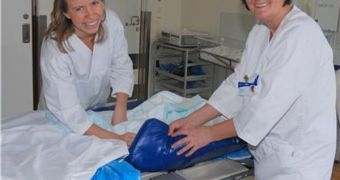Auxiliary maternity nurse Astrid Skreosen got fed up one day with all the bedsheets that her maternity wards had. None was too good to fit the actual beds on which women gave birth, and they were also not absorbent enough to cope with a restless birth process. So, she was referred to SINTEF Materials and Chemistry expert Per Stenstad, with whom she devised a new type of material, just one millimeter thick, but able to absorb large amounts of wastes and blood, AlphaGalileo reports.
“Restless women in labor and unstable mats made problems for everyone. None of these underlays fitted the delivery beds, and we were wading in fetal fluids and blood. I was just as irritated by people who said that we shouldn’t complain, but just make the best of things,” the nurse says of the reasons that drove her to take matters into her own hands, and stop complaining to those hierarchically above her. She decided to team up with SINTEF after some unpleasant experiences with inventor advisers.
“The principle of an absorbent polymer material is well known. It functions rather like a nappy. In this case, the challenge was that the sheet must be only a millimeter thick, without letting dampness pass through it. The set of sheets also had to consist of two parts in order to be suitable for the labor bed,” she says. After consultations with Stenstad, her company, ASAP Norway, was ready to go. All this took place by Christmas 2007, when her company had gotten further enough with the science behind the new bedsheets to allow her to apply for funding.
“We carried out a survey of damp-absorbent polymers in use today; for example in nappies. Most of these are based on polyacrylic acid, and we have used a powder that is based on this powder. We have managed to produce prototypes that are only 0.1 mm thick by fixing a thin layer of absorbent powder directly to the base layer,” Stenstad says of the new materials the team obtained. In addition to maternity ward bedsheets, the two also developed a number of other textile materials, also with the ability to absorb a lot of liquid before becoming permeable.
The duo are now looking for a company to produce their materials, and have applied for a patent. There are numerous uses for their bedsheets, they say, so hopes are high that some investors would become interested in their efforts. “This bed sheet can be used in maternity wards and in field hospitals anywhere in the world. Another option would be to use it in operating theaters and ambulances,” Skreosen concludes.

 14 DAY TRIAL //
14 DAY TRIAL //